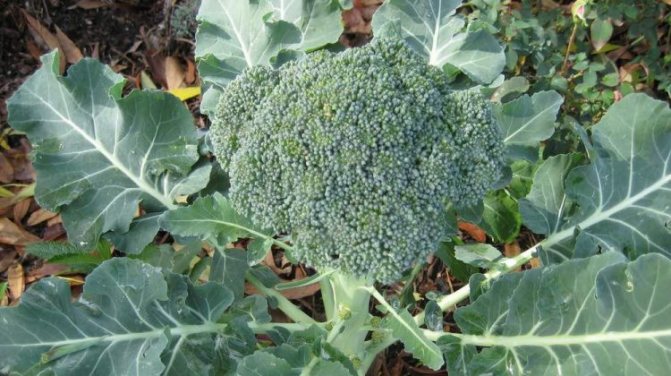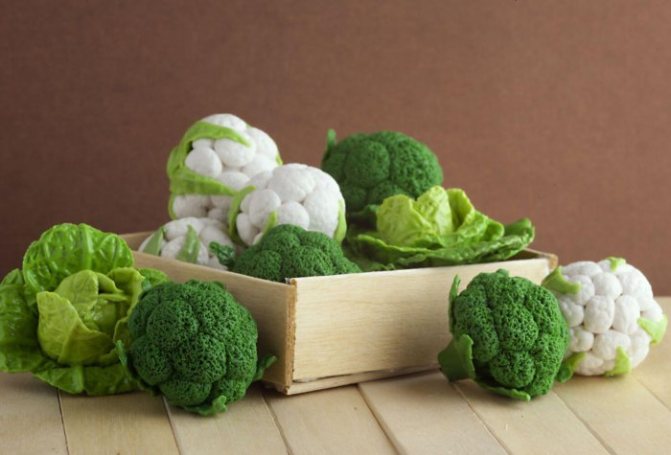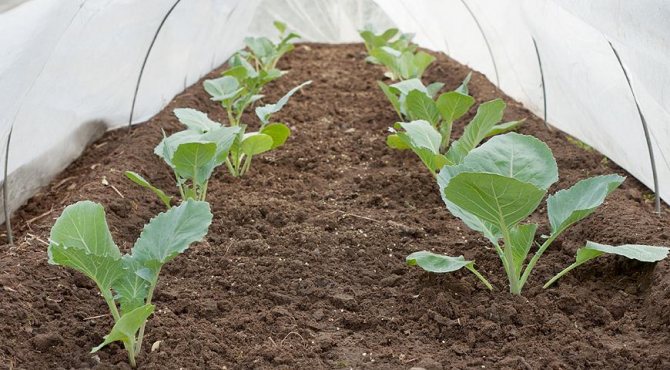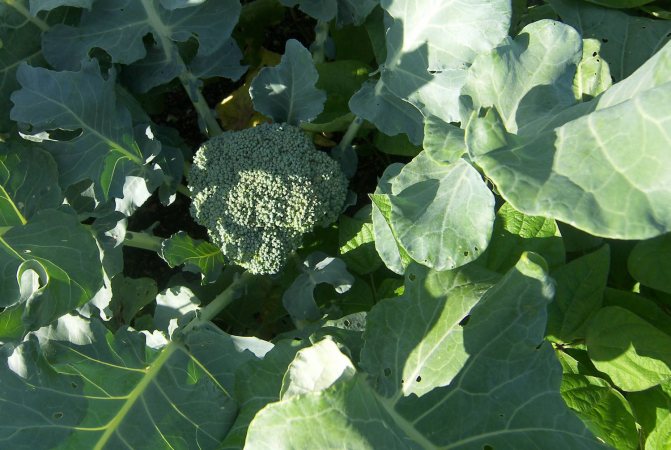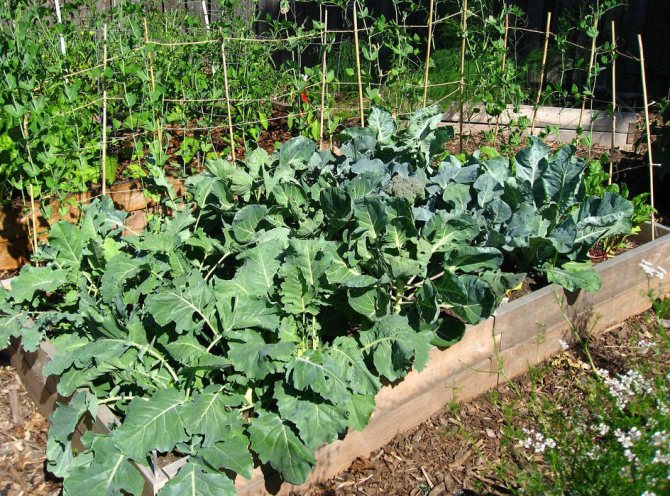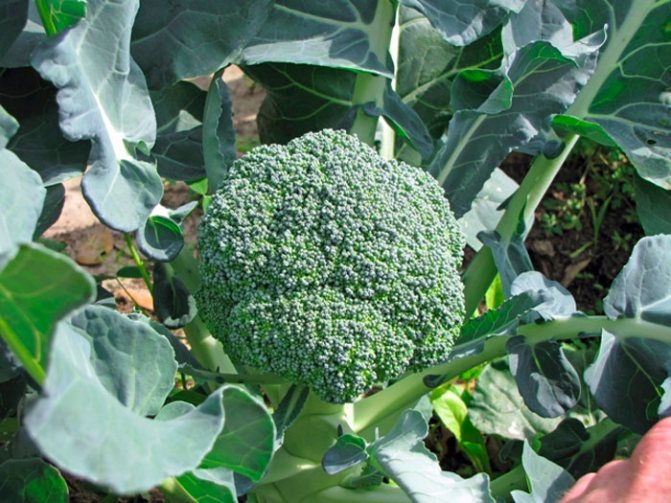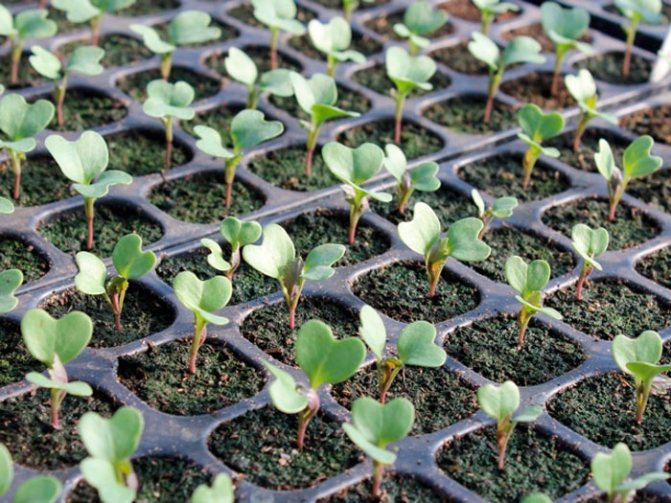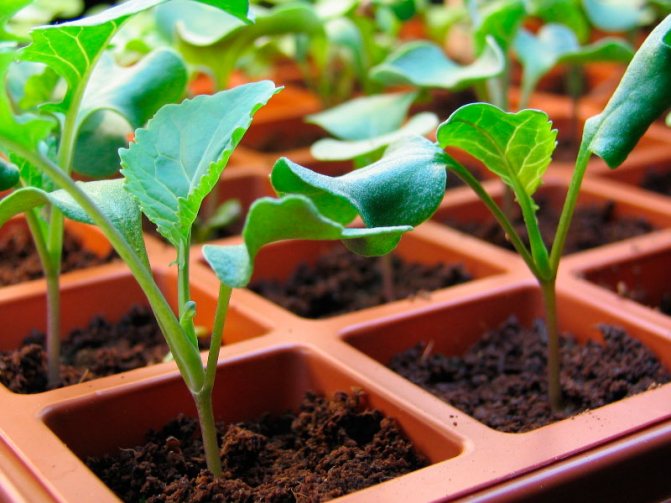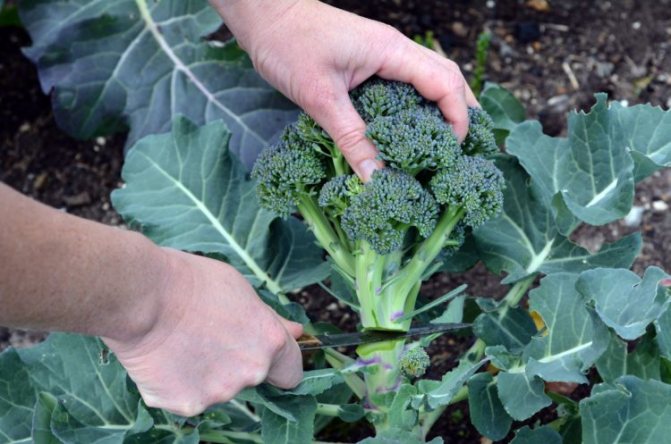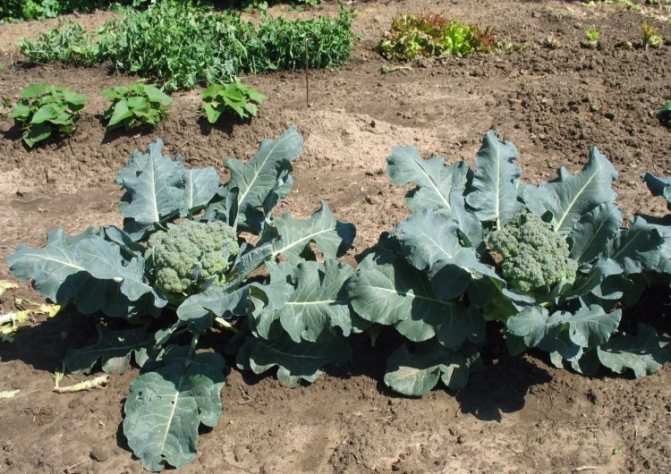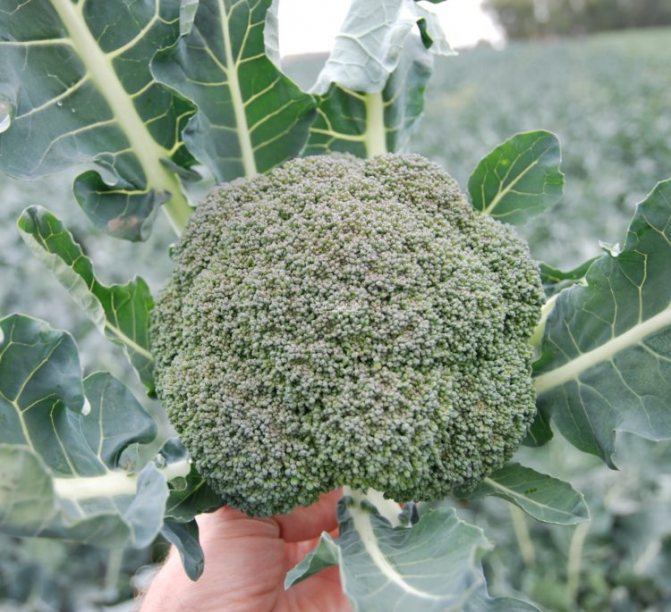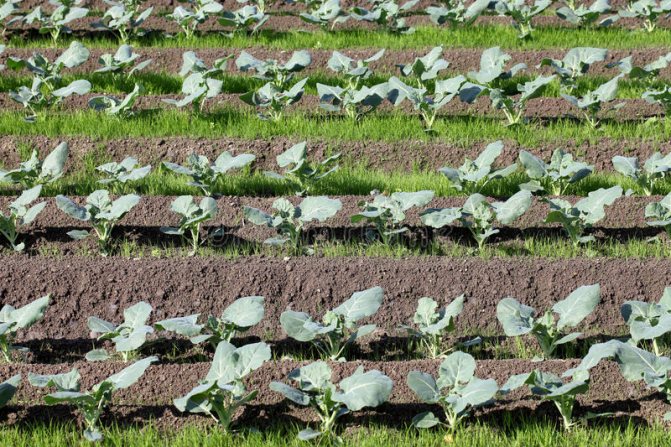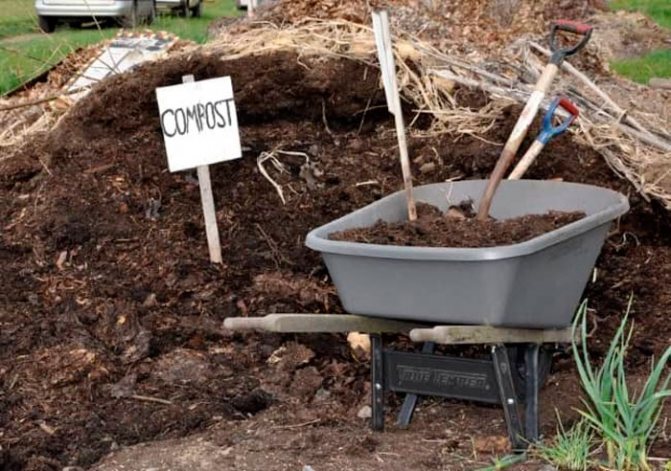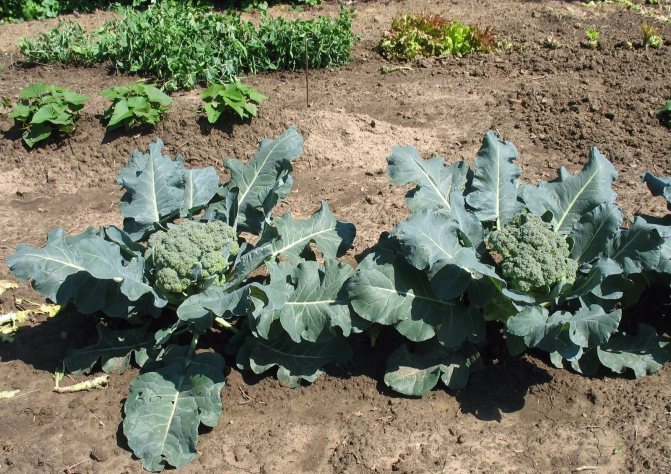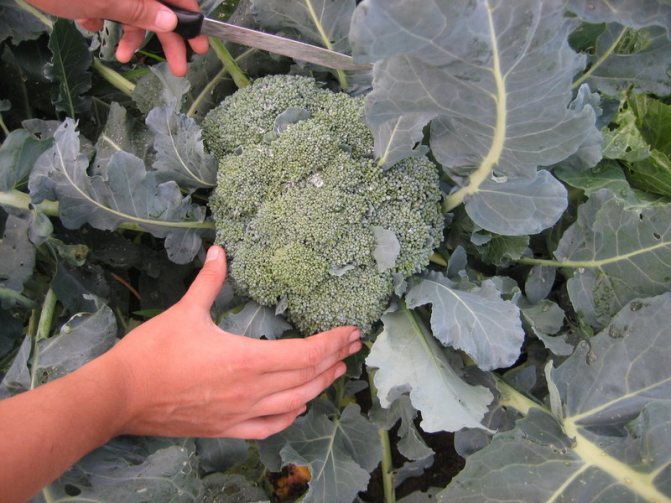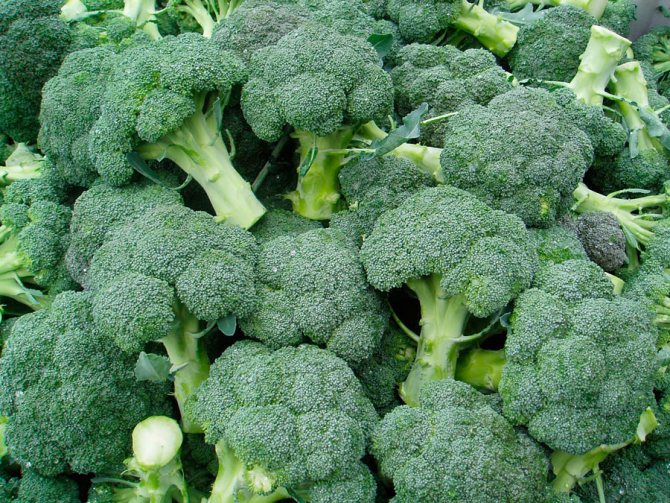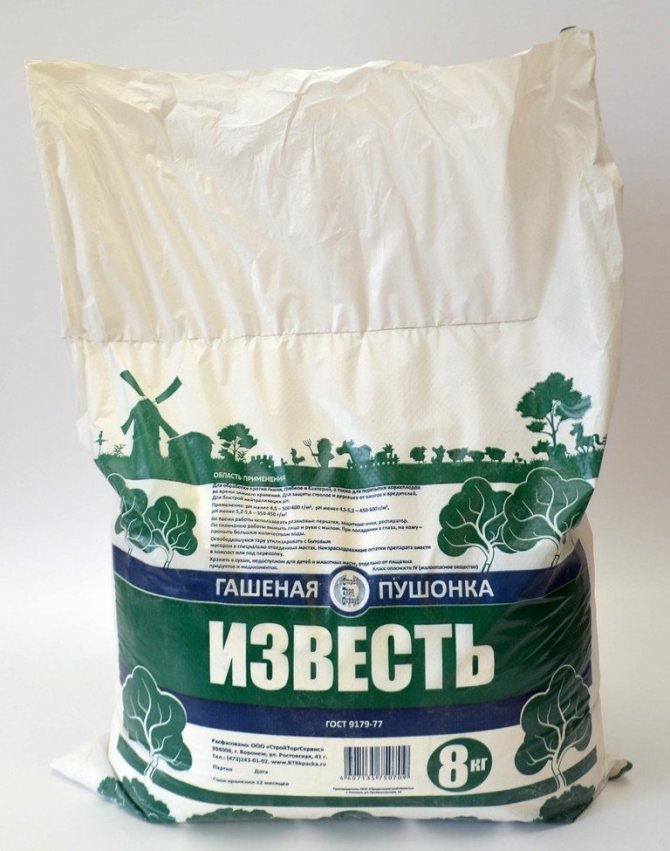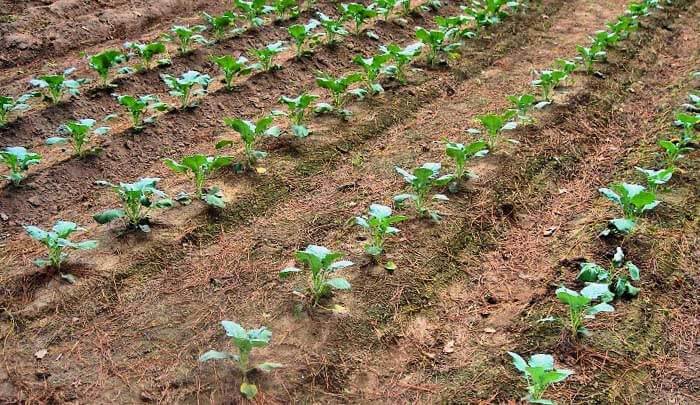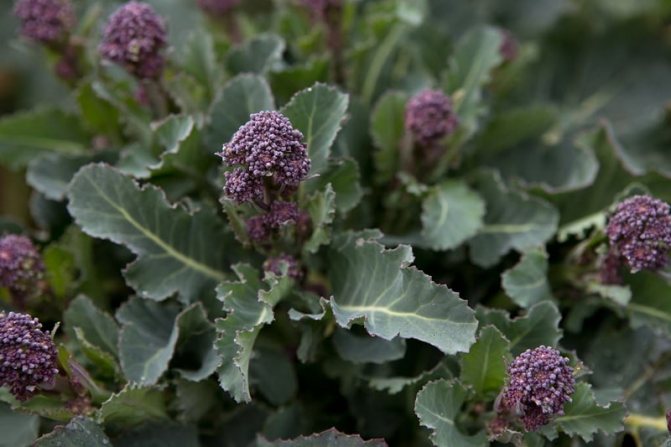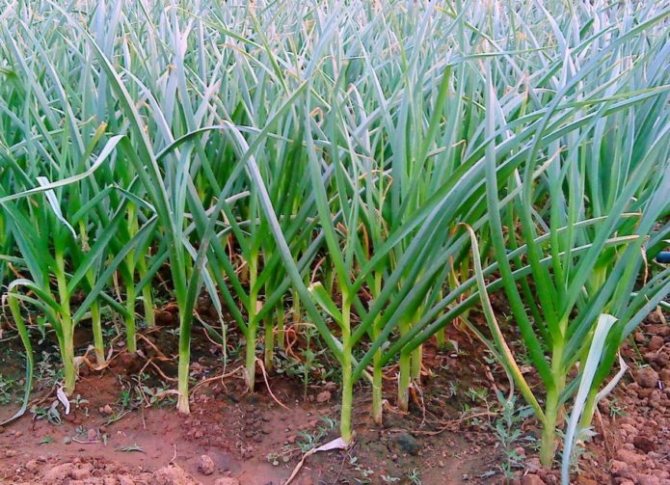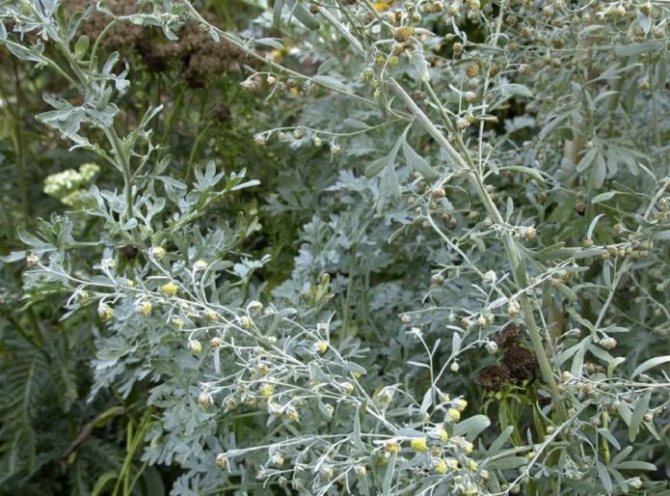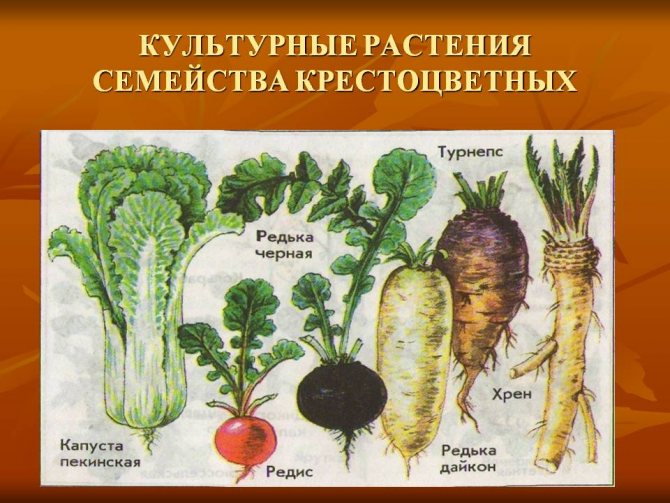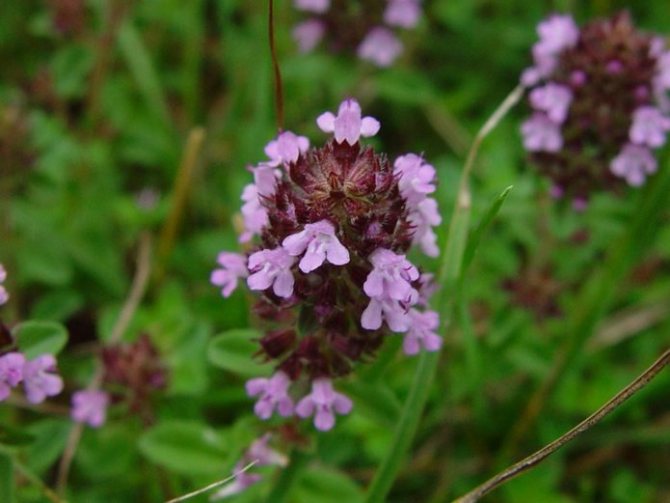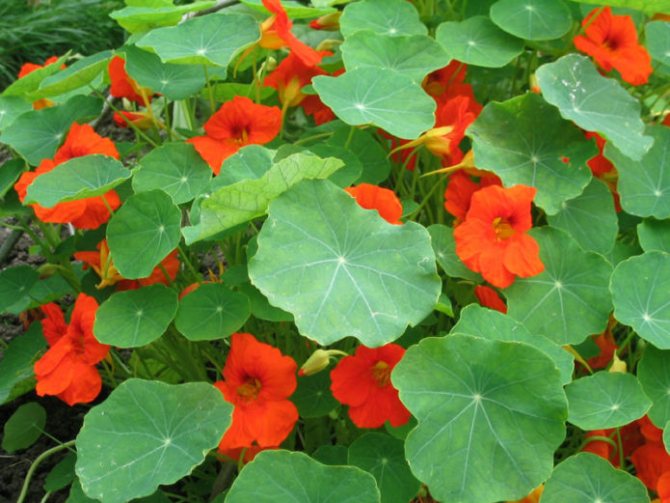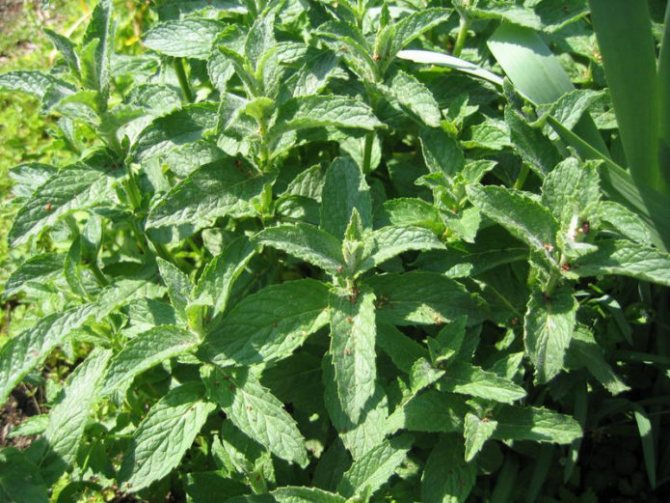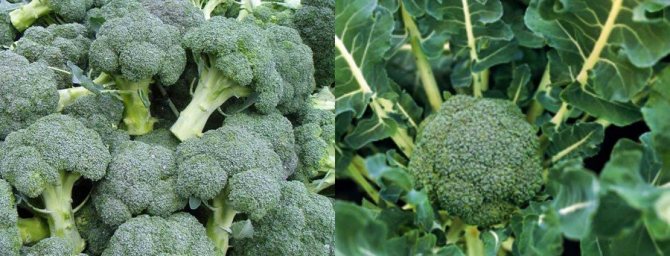An interesting variety of cabbage, in which not leaves are used as food, but unblown inflorescences, look at the photo. Broccoli does not require special care when growing, it is resistant to arid soil and temperature extremes. It can be grown on a garden plot in the open field.
This variety is an annual plant that loves sunny, warm places. It features a spreading rosette with large leaves, grows in height up to 90 cm (depending on growing conditions). The inflorescences are a bit like cauliflower, but the heads are loose. In colored ones, they are more elastic.
Many hybrids form lateral shoots, on which heads with inflorescences also develop, but smaller in comparison with the central one. Cutting off the central inflorescence accelerates the development of lateral shoots.
This vegetable is valued as a dietary product, because its calorie content is only 28 kcal / 100g of the product. It is rich in vitamin and mineral composition, biologically active substances, which are used to heal the body and to prevent diseases.
Before sowing, you need to decide on the variety of cabbage. Which hybrid is right for your climatic conditions.
Features of vegetable cultivation
It is recommended to plant broccoli in the soil where previously carrots, onions, any cereals, legumes or potatoes were used.
The plant is distinguished by its unpretentiousness, so it is quite simple to care for it. Despite this, broccoli is very demanding on light and moisture.
Features of growing broccoli:
- Where does the vegetable grow better? According to experts, the best soil for broccoli cabbage is a mixture of turf, sand and peat. It is highly discouraged to use old land from the garden, because it can become infected with blackleg and infect the plant.
- It is better to shade the ripening heads of cabbage from direct sunlight, otherwise they will acquire an unpleasant and untidy appearance. And on especially hot days it will be useful for plants to organize spraying of the air around.
- As mentioned above, the vegetable must be well watered. But in everything, a measure is needed, in the case of an excess of moisture, there is a risk of infection with a black leg and decomposition of the roots, and in case of a shortage, the plant heads will be tiny and lethargic.
It is not recommended to plant broccoli earlier than 4 years later in the same places.
Preparation of soil and containers
Broccoli, like any other variety, prefers nutritious and loose soil, through which moisture and air penetrate well. To prepare a soil mixture of the correct composition, it is necessary to mix rotted manure or compost with turf soil in equal proportions. In addition, fertilizers containing micro- and macroelements are added to the mixture. To do this, you can use wood ash at the rate of 1 tbsp. l. for 1 kg of soil.
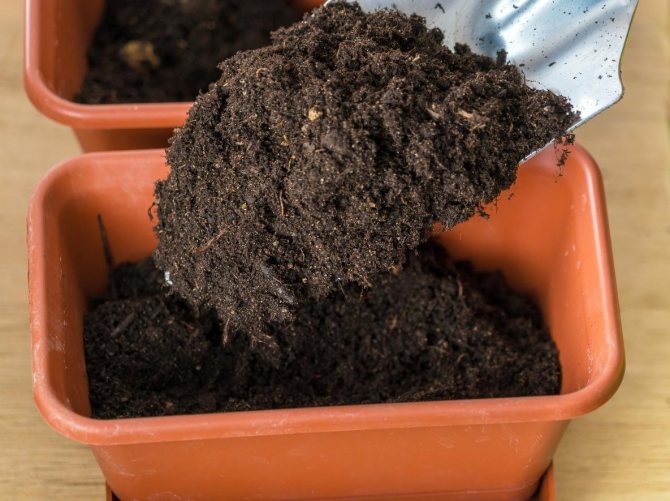
The soil for broccoli seedlings should be nutritious and loose, for which they use sod land and rotted manure
In the process of preparing the soil mixture, you can replace the sod land with peat with the addition of sand. If there is no desire or opportunity to prepare the substrate yourself, you can buy a ready-made one.
To reduce the likelihood of infection of young plants with various diseases, it is not recommended to take land from the garden, especially from the place where the cruciferous crops (radish, radish, cabbage) were cultivated. The fact is that in such a land, most likely, there are pathogens characteristic of these plants (fusarium, black leg, gray rot, etc.).
Preparing the soil for growing seedlings also includes a disinfection stage. To do this, 2 weeks before the intended sowing of seeds, the soil is steamed in the oven at a temperature of + 200 ° C for 15 minutes. After the substrate has cooled, it is spilled with potassium permanganate (1% solution). For these purposes, you can use other drugs, such as Fundazol, Gamair.
For growing broccoli seedlings, both homemade wooden boxes, plastic containers, and special cassettes are suitable. If sowing in large volumes is planned, then such containers will be the best option. With a small number of landings, you can use plastic cups or bottles, pots, etc. The main thing is that there are drainage holes on the bottom of the containers. Before sowing seeds, containers are recommended to be treated with potassium permanganate.
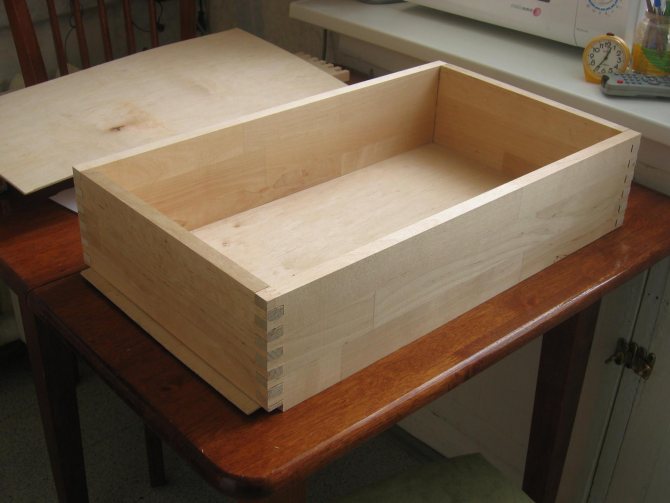

Homemade boxes or special cassettes are suitable for growing seedlings.
Differences in breeding from other representatives of the cabbage family
Broccoli is often confused with cauliflower, but it differs in appearance and is considered more fruitful. After removing the heads in the center, a new crop is formed on the lateral shoots. For details on how broccoli differs from cauliflower, we talked here). It is better to reduce the amount of water during the formation of the heads.
Broccoli also tolerates heat and cold more easily and can be grown on any land. For the normal development of large heads, you need a minimum amount of nitrogen, a sufficient amount of phosphorus and potassium, as well as good lighting. It ripens in a shorter time, unlike other species, the heads ripen faster.
Benefits of Broccoli and Cooking Uses
In terms of vitamin C content, broccoli is ahead of all known related species - about 500 mg of the substance is found in one medium-sized head. The vegetable is rich in potassium, folate, calcium, iron, phosphorus and magnesium.
Broccoli is recommended for people diagnosed with gastrointestinal diseases because it is easily digested and overweight. The calorie content of the product is 34 kcal per 100 g.
Attention! Vegetable crops contain antioxidants and substances that prevent the formation of cancer cells, such as glucoraphanin, diindolylmethane, and germinated seeds are rich in sulforaphane.
Broccoli is used to prepare side dishes and first courses. It is boiled, stewed, blanched, baked and fried. Long-term heat treatment of the product leads to a decrease in the concentration of nutrients in the cells of the inflorescences, therefore nutritionists recommend preparing the product in a double boiler.
Photo
Below in the photo you can see how broccoli grows:
Growing through seedlings
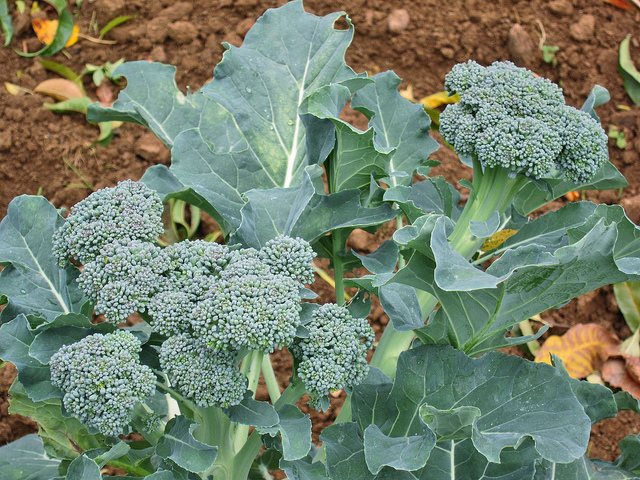

So what do you need to know about this? How to plant broccoli outdoors? The best time to plant seedlings is from early to mid-March. As for the choice of a variety, you should definitely take into account the climate of a particular area. For example, in the northern parts of the country, summers are quite cool and short, so it is better not to use late ripening varieties for planting. In this case, medium early and early varieties are more suitable.
To avoid future surprises, try to purchase broccoli seeds only from specialized stores. Better to give preference to fresh seed. It costs more, but the result will be excellent.
Where and for how much is the seed sold?
Broccoli seeds can be ordered and bought at the Semena Tut store, the price of the assortment ranges from 11 to 48 rubles. Moscow, Zvenigorodskoe highway, 9/27. Seeds are also available in St. Petersburg.
You can also order in the Internet trade center "Regmarkets", where a large assortment is presented for any choice, both in terms of price and in terms of the manufacturer. If you plan to buy in a regular store, as an option, you can look at the addresses in the search and select a suitable one nearby.
Comparison of seeds of different varieties
There are early ripening varieties of broccoli cabbage, and there are hybrids resulting from the merger of key varieties. Seeds of an early maturing variety are suitable for planting next year. The downside is that such varieties are not very productive and are not suitable for long-term storage.
Broccoli hybrids are not suitable for planting for the next harvest... But, practically not damaged by pests. Compared to early maturing, they are much more productive. The formation of fruits occurs earlier, and they can be stored longer.
| Variety | Growing medium | Ripening period (days) | Weight (gr) | Yield (kg) | Characteristics |
| Batavia F1 | Open ground and greenhouse | 95-102 | 0, 6-2 | 2,6 | Shifts carriage |
| Vyarus | Greenhouse | 65-75 | 0,2-0,3 | 2,9 | Resistant to unfavorable temperatures |
| Curly head | Open ground and greenhouse | 80-95 | 0,5-0,6 | 2,4-3,6 | Disease resistance |
| Stromboli F1 | Open ground and greenhouse | 65-70 | 1 | 2,5-3 | Resistance to bacteriosis |
| Jung F1 | Open ground and greenhouse | 60-65 | 0,2 | 1,3 | High in β-carotene and vitamin C |
How to choose the best ones?
The future yield of broccoli depends on the selected seed variety. You also need to proceed from what time of the year the planting itself will be carried out.
Growing broccoli cabbage from seeds begins in the first half of March - that's when broccoli seeds are sown for seedlings.
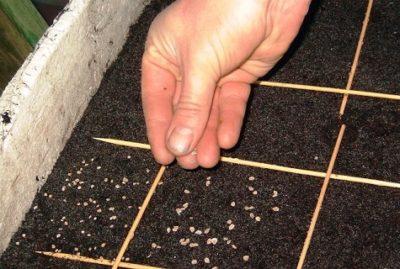

You can sow broccoli cabbage seeds by conveyor method, at several times every two weeks until mid-June, but from the end of April, broccoli is planted in a non-seedling way directly into the ground.
There are many varieties and hybrids of broccoli, but which are the best? You can choose the right ones according to 2 important aspects.:
- Pay attention to the ripening time of the varieties. Hybrids reach the stage of readiness by 50 days, late ripening time is considered to be 140 days or more. Therefore, it is strongly recommended to opt for early ripening varieties for the conditions of the short warm season.
- For yield. From 1 square meter of planting, you can collect from 1 to 4 kg of fruits, and in some cases even 7 kg, depending on the quality and characteristics of the varieties.
Varieties and hybrids of broccoli cabbage with photo
According to its biological characteristics and usefulness, this variety overlaps the properties of cauliflower:
- It is more cold-resistant
- Has a strong immunity to diseases and pests,
- Has a good yield,
- It is characterized by remontance (the ability to re-flowering and fruiting),
- Refers to undemanding cultures,
- In addition to the heads with inflorescences, shoots that grow up to 10-15 cm are used for food.
The most popular varieties of cabbage: calabrese, which has a dense inflorescence on a plump stem, and Italian cabbage (asparagus), in which the heads of inflorescences are small in size, are formed on numerous stems.
Of these two varieties, breeders have bred about 200 food varieties, which, according to their growing season, are subdivided into early, late and mid-season varieties and hybrids. I want to cite just a few of them:
Varieties with a short growing season - early
"Fiesta" - grade fast ripening, ready for use in food after 70 days. It differs in a larger inflorescence, juicy and dense, the head weighs up to 300 g. Reparability is not inherent in this variety, it does not give lateral stems.
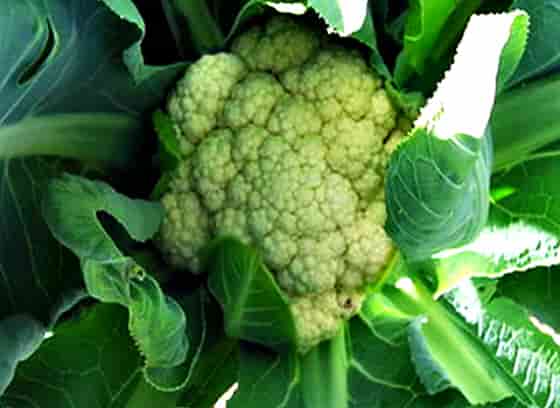

Broccoli cabbage Fiesta F1
The inflorescences can be kept refrigerated for 14 days.Long shelf life and consumption of food can harm the body.
"Green Magic" - a hybrid of the first generation. The first crop can be harvested after 65-70 days. On a raised leaf rosette of leaves, an inflorescence is formed weighing up to 700 g. The inflorescence is emerald in color with a bluish tint, round, dense. Possesses high resistance to flowering, gives additional shoots with inflorescences.
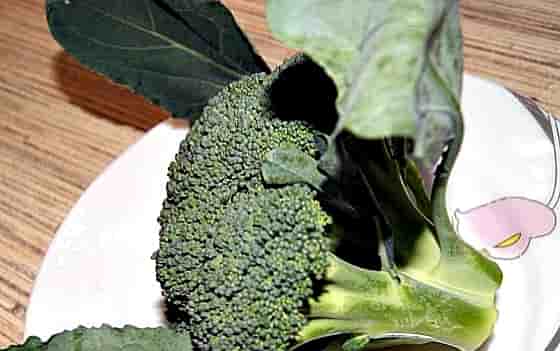

Broccoli Green Magic
Early hybrids include: "Tribute", "Vyarus", "Green Sprouting", "Corvette"
Mid-season varieties and hybrids
Variety "Linda" ripens 80-85 days and belongs to the mid-season. The inflorescence is large, up to 400 g, but soft and loose. Suitable for raw consumption.
Variety "Tonus" ripens in 80-90 days. Heads with inflorescences are dense, weighing up to 200 g. Resistant to diseases and temperature extremes. After cutting, it gives new shoots, on which heads with a mass of up to 70 g are formed. The vegetable is used for eating raw (salads) and for canning. Long-term storage does not tolerate.
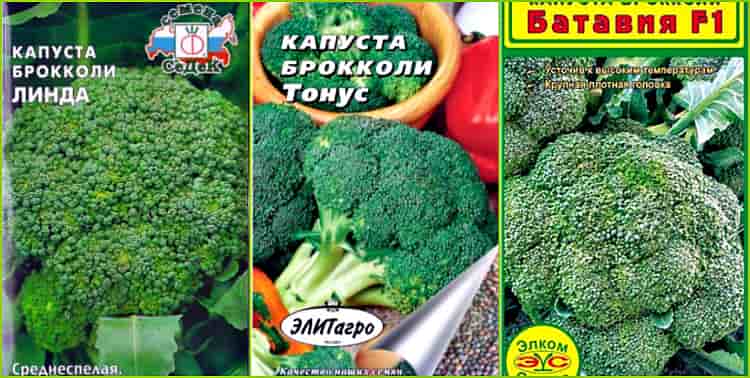

"Batavia" - hybrid first generation, medium early ripeness. The sizes of the flower heads form a large head of cabbage from 800 g to 2 kg. In the southern regions, it is grown as an early vegetable.
The leaves are green-bluish in color, wavy and bubbly, the rosette of the leaves is raised. The vegetable is tasty, has good keeping quality, therefore it tolerates long-term transportation. Lateral shoots form heads weighing up to 200 g.
Calabrese, medium early variety. It is characterized by cold resistance, dense head of inflorescences weighing up to 400 g and good yield from lateral shoots. Resistant to temperature extremes.
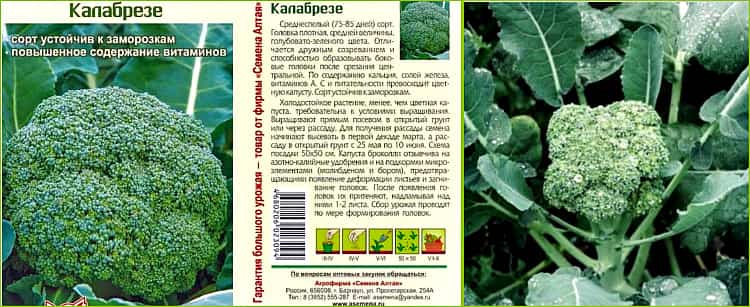

"Macho" - mid-season hybrid of the first generation, with large green leaves. Delicate bluish tint to the leaves, gives a thin layer of waxy bloom. Heads of cabbage grow in 30-40 days, after planting seedlings in the ground, weighing up to 200 g. They have a rich dark green color. After cutting, it quickly picks up heads on lateral shoots.
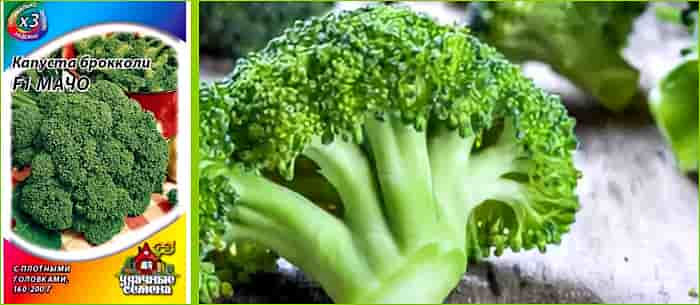

Mid-season hybrids include: "Gnome", "Green Favorite", "Senshi"
Late ripening varieties and hybrids
In late-ripening hybrids, the technical maturity period is delayed to 130-145 days. These include: a hybrid "Arcadia", with a harvest ripening period of up to 110 days. The head consists of many inflorescences, the total weight of which reaches 450 g. A large number of smaller inflorescences (70 g each) develop on the lateral stems.
Marathon F1, Continental, Romanesco, Monterrey, Belstar, Surfing F1 are also hybrids with late ripeness, which are used for winter harvesting.
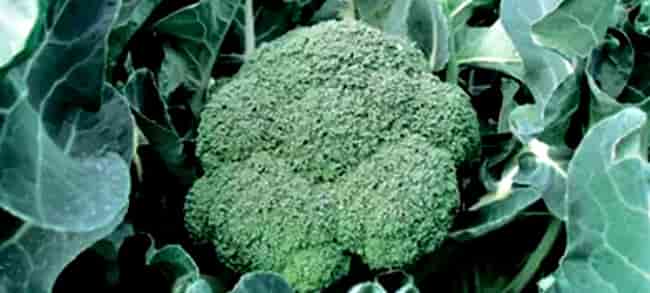

Broccoli cabbage Belstar
For central Russia and the Moscow region, the best varieties for growing in the open field are: "Tonus" and "Kolobok", "Corvette" and "Vyarus", "Comanche" and "Baro", "Marathon" and "Emperor", "Laki" and "Vyarus".
For the regions of Siberia and the Urals, varieties with greater resistance to temperature extremes are suitable. Late hybrids in these territories do not have time to give a harvest, therefore early ripening varieties are popular: "Tonus" and "Lazar", "Vyarus" and "Linda", "Macho F1" and "Fiesta", "Green Magic".
How to grow in the country - step by step instructions
Seedling method
This method is simple in that you just need to plant the seeds. The largest are selected first. They are sown approximately 35 - 40 days before disembarkation in open ground. They are usually planted in boxes with soil or in a greenhouse, to a depth of about 1 cm and with a distance of 2.5 cm between the holes.
Many gardeners sprinkle a selected plot of land with ash, lime or dolomite flour before sowing to provide the necessary trace elements. And only then they dig it up. Use humus and mineral fertilizers. Some time before planting, the soil should be fertilized with compost, in the calculation - 1 bucket per 1 sq. m... The temperature of the environment in which the seeds will develop should be 20 degrees. Then the temperature can be reduced to 15 degrees, maintaining it steadily until disembarkation.
Watering is required well, but not to allow excess moisture, because this can lead to blackleg development. The first sprouts of seeds growing in the greenhouse break through after 10 days at a temperature of 10 degrees.
At temperatures above 10 degrees, the first shoots appear in 3-4 days... After 1.5-2 weeks, you can already observe 3-4 leaves. During this period, they are seated in separate containers, or directly in the greenhouse, if the temperature allows it. The depth of the holes should be about 25 cm, and the distance between plantings should be at least 40 cm.
One of the ways to transplant seedlings:
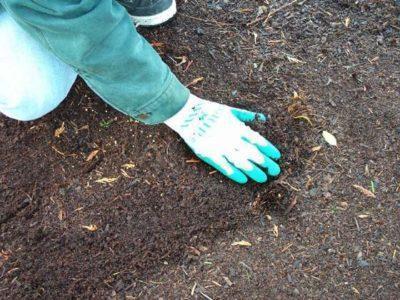

first, prepare a bed (you need to dig up a bed, then fertilize with humus, 30-40 g for each bush);- liming in a few weeks in order to lower the acidity of the soil;
- add compost (10 l / m2) to keep the temperature cool;
- 10 - 15 cm plants can be transplanted into the garden bed;
- water;
- dig holes 8 cm deep (the soil should reach the level of the leaves);
- it is worth pinching off the main root a little in order to subsequently achieve a good root system;
- at the end, pour water well.
Neutral and slightly alkaline soil is excellent. Also, the soil for sowing can be prepared as follows: mix sand with turf and peat, laying limestone on the bottom. To disinfect the soil, you need to perform the following actions:
- warm up the ground a couple of weeks before sowing;
- 24 hours before sowing, to prevent black leg, water the soil with a solution of potassium permanganate.
Planting directly into the soil
Already in May, subject to warm weather, broccoli seeds can be planted in a seedless way. In the same way that was indicated above, the land is cultivated and prepared. It should be planted in wet and fertilized soil. After the appearance of 2-3 leaves, you need to weed and thin out the planting, the distance between the bushes should remain about 40 cm.
Growing broccoli in the open field
Broccoli loves bright, warm places, so choose a sunny spot for it. Prepare loose and fertile soil, neutral or alkaline. Planting precursors can be legumes, potatoes and carrots. And the beds where cruciferous plants grew (turnip, radish, cabbage, radish) should be avoided. This reduces the yield.
Experienced gardeners prepare the soil for cabbage in the fall, enriching it with humus, minerals or fertilizers. Phosphorus and potassium are useful for cabbage, lime is fluff. But the lack of nutrients in the soil can always be compensated for by timely feeding.
When to plant seedlings. When planting seedlings in open ground, the plants should have 4-5 true leaves (excluding cotyledons) and a developed root system. In our region, cabbage is planted in the ground in early June. We must be guided by the weather of our region and wait for night temperatures not to drop below 0 degrees.
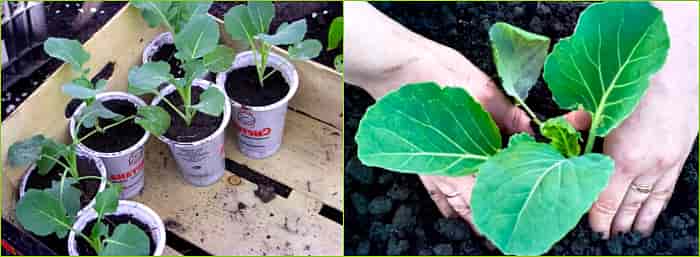

Transplanting seedlings into the ground
The main criteria that must be taken into account when transplanting seedlings into the ground:
- seedling age 35-40 days,
- plants are healthy and well developed with 5-4 true leaves and a strong root system,
- the place is sunny, the earth is fertilized.
Prepare cabbage holes in advance, between which maintain a distance of 40 x 60.
If the soil has not been fertilized since autumn, a bucket of humus should be mixed with 2 glasses of ash, 2 tablespoons of superphosphate and a spoonful of urea. Divide this mixture into 4 holes, mixing well with earth.
After moistening the earth, plant one cabbage bush in each hole. Shed again and cover with a covering material until the seedlings adapt to the new conditions.
How to care for broccoli
Caring for cabbage includes watering the plants, loosening the soil, weeding and hilling, feeding and protecting from pests.
Loosening is carried out not deep so as not to damage the root system. It is advisable to do it after watering to close the ground from evaporation.
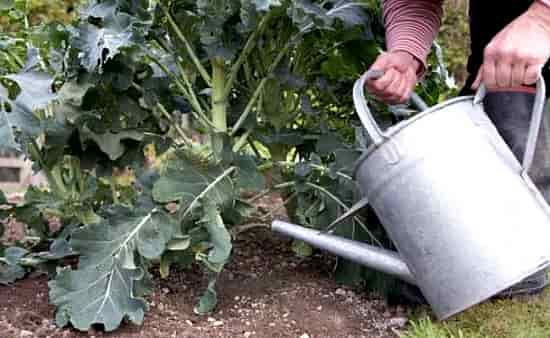

In the early days, cabbage is watered daily, and after that, once a week is enough. But again, they are guided by local conditions. If there is daily heat and there is not a cloud in the sky, then you will have to water more often. Cabbage loves watering both at the root and on top of the leaves.
Plant feeding
Plant feeding can be scheduled as early as 14 days after planting seedlings in the ground. Plants benefit from feeding from fresh mullein infused with water (250 g per bucket of water). Add a tablespoon of nitrogen fertilizer to the infusion and water the plants per square meter - a liter of infusion. Chicken droppings are also used.
The second feeding is carried out 20 days after the first, in which the emphasis is on nitrogen fertilizers. Ammonium nitrate (matchbox) is added to a bucket and a half of water. Per square meter of soil, pour a liter of fertilizer.
The third top dressing is important for cabbage at the end of summer, emphasis is placed on phosphorus and potassium elements (10-11 grams of potassium sulfate and 35 g of superphosphate are mixed per 15 liters of water). Now, per square meter of land, 1500 ml of solution is consumed.
After cutting the central head of the inflorescence, the plants are fed again to speed up the ovaries on the lateral shoots. Dissolve nitroammofosk in a bucket of water and pour a liter of solution under each bush. And a week later, ash - potash fertilizer is sprayed onto the wet ground (150-200 g for each root.
How to care for crops?
Caring for broccoli primarily includes watering the plants, every day or every two days. After irrigation procedures, it is necessary to loosen the soil. To humidify the environment, you can use spraying... As the first top dressing, you can use urea, for this 2 tablespoons are added to 1 bucket, for about 15 bushes.
Two weeks later, a second feeding is carried out, you can mix manure with water (1 to 4). The third feeding is carried out when the inflorescences begin to ripen, with a superphosphate solution (also 1 tablespoon per 1 bucket).
Further care of the plant consists in:
- inspection of plants (removal of bad leaves, etc.);
- chemical treatment (for the prevention of diseases and pests);
- loosening the soil;
- watering as it dries;
- extraction of affected plants;
- airing the greenhouse.
Preparing broccoli seeds for sowing
Before sowing, broccoli cabbage seeds need processing, which is carried out in order to disinfect, accelerate germination and sort out poor-quality seed.
Sorting
For sowing, it is advisable to select only large seeds, but you can use medium ones. Small and damaged grains must be removed. Calibration can be done with a suitable mesh (about 1.5 mm). There is another way: the seeds are placed in a 3% saline solution for 5 minutes. All that remains on the surface is thrown away. Seeds settled to the bottom are considered suitable for sowing. After this solution, they are washed in clean water.
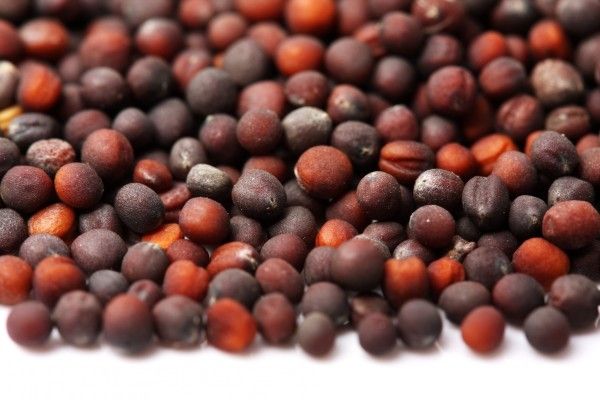

Seeds of broccoli cabbage are sorted before sowing, selecting only large and medium grains
Disinfection
To process seed material from various pathogens, it is soaked in a solution of potassium permanganate for 20 minutes, and then washed. Many gardeners use this method, but there is an equally effective method of disinfection - heat. To do this, the seeds are poured into a thermos and poured with hot water (+ 60˚C) for 25 minutes, after which they are washed with cold water.
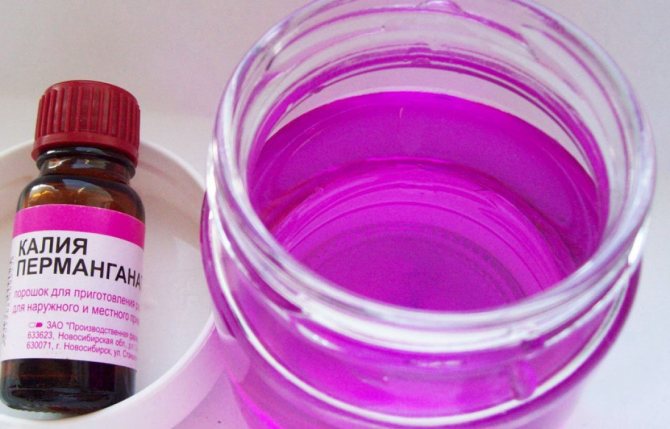

For disinfection, broccoli seeds are placed in a potassium permanganate solution for 20 minutes.
Germination
Seeds can be germinated both in ordinary water and in growth stimulants, for example, Heteroauxin, Kornevin, etc.It is possible to prepare a nutrient solution based on wood ash (1 tablespoon per 1 liter of water), in which the seeds are soaked for several hours. After processing, they are washed, placed on the lower shelf of the refrigerator for a day, and then dried and proceeded to planting.
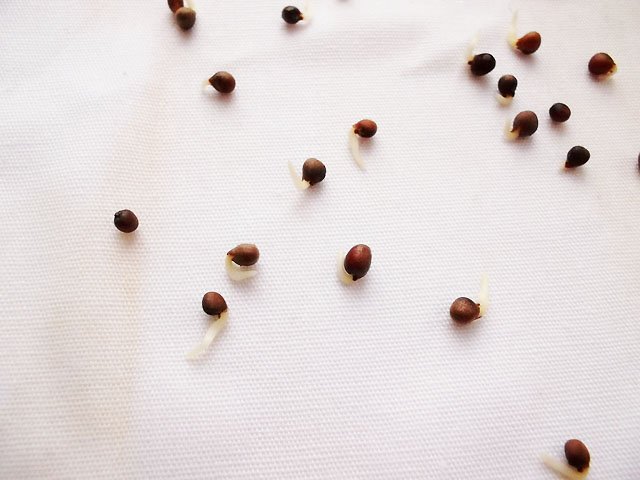

Seeds of cabbage are germinated in plain water or in growth stimulants for faster germination
Harvesting
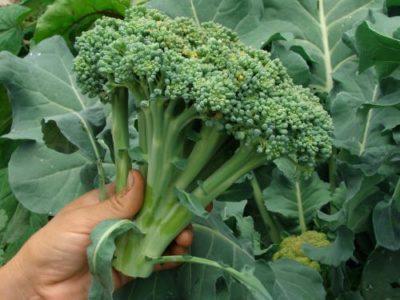

After 3 months, when the buds are fully ripe, but have not yet opened, the central head is cut off with a part of the main stem, the length of which should be 15-20 cm.
Due to the heat, if the broccoli heads are not darkened, they quickly open and bloom... Therefore, it is recommended to harvest every 2-3 days, and during bad weather - once every 7-10 days.
The approaching harvest can be identified by decrepit inflorescences, which bloom the very next day. Early harvest is suitable for storage for a relatively short time (several days), while autumn harvest is long-term.
Do not forget that some broccoli varieties also ripen the side shoots. They begin to form faster after cutting off the main ones. Therefore, you can continue to look after them and get large heads. When they grow up, they are also cut off.
Description of the plant
Broccoli is an annual plant belonging to the Cruciferous family. The length of the stem varies between 70–90 cm. The leaf blades are very large, smooth to the touch with wavy edges, equipped with elongated petioles.
At the end of the shoot, a loose conical head ripens, weighing from 150 to 600 grams, consisting of small inflorescences tightly pressed against each other. Unopened buds are colored green, flowers are yellow. The heads are eaten, cutting them off before flowering. Broccoli bears fruit for several months, up to frost, since the removal of the central inflorescences provokes the formation of new heads.
Asparagus, as it is also called for the similarity of taste to asparagus, is an early maturing and frost-resistant crop. An adult plant is able to withstand a short drop in temperature to -7 degrees. Hot weather has a bad effect on the quality of the heads - they grow loose and begin to bloom early. This cabbage species cannot be called too demanding and capricious. Broccoli develops and bears fruit normally in different soils as long as they are well hydrated.
Diseases and pests
- Bloom:
- non-compliance with sowing dates (early disembarkation);
- not harvested on time;
- insufficient or lack of watering.
- Peronosporosis:
- high humidity, that is, excessive watering of plants;
- aspects of the weather resulting in increased humidity.
- Fungal disease, you can identify it by bloom or brown spots.
- Keela is a disease promoted by fungus. If the plant is not removed, the fungus will spread to others.
- Blackleg - as mentioned in this article, develops due to high humidity and is also a fungal disease. As a result of its development, the plant dies.
- Alternaria. A symptom of this fungal disease is black spots. It is born after heavy rains and warm weather.
- Powdery mildew. It can appear in the fall, flour-shaped bloom and star-shaped spots appear on the leaves. This may be due to fog or lack of precipitation in hot weather.
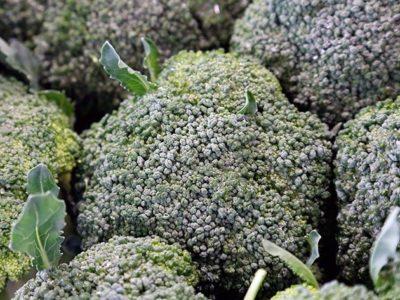

Turnip mosaic is a viral disease that spreads such a pest as aphids. Can be identified by plant growth retardation and mosaic spots.- Mucous bacteriosis. The cause of this disease is bacteria that simply kill the plant. Signs - leaf decay, stem softening.
- Vascular bacteriosis is the same bacterial disease. It affects all parts of the plant.It occurs due to the following factors: moisture, constant precipitation and pests. As a result, the vegetable dies.
- Bel is a fungal disease that damages the leaves and aerial parts. Likewise with black annular spot.
- Fomoz. The disease manifests itself if the seed has already been infected. Light spots and black specks capture the stems, roots, as well as cotyledonous leaves.
Read more about the beneficial properties of broccoli, as well as about contraindications to its use, and from this article you will learn about how this vegetable can be cooked.
Like all other fruits and vegetables, broccoli also needs timely care, although it is not particularly whimsical. If you follow all the requirements of cultivation and care, you can have your own mini broccoli cabbage factory at hand.
History of origin
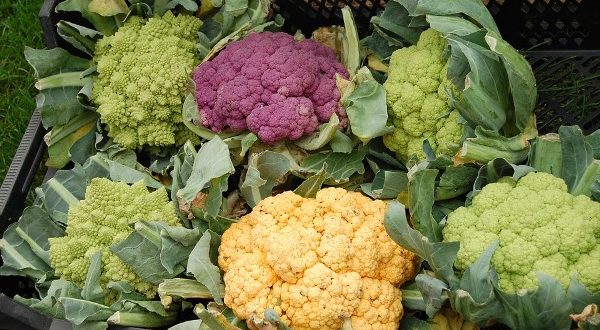

For a long time, broccoli was grown exclusively on the lands of modern Italy. Translated from the language of this country, the word broccoli means "shoot". Anyone who has seen such a vegetable will understand why it was called that. The first description of it is found in manuscripts dating from the end of 1587. Around the 18th century, the culture first came to England, where it began to be presented as Italian asparagus. Broccoli simultaneously came to the American continent, but could not get the same distribution as in England. Only in the 20th century did they remember this vegetable in America. The country is by far the largest exporter of broccoli. Also, this variety of cabbage is successfully cultivated in China, France, India, Italy, Spain, Israel and Turkey.
In Russia, only a few small farms are engaged in the production of this product. In this review, we'll look at how to plant broccoli in your garden. Growing and care in the open field, as a rule, is primarily of interest to gardeners.
Frequently asked Questions
How to grow the Fortuna variety
Cabbage Fortuna can be grown both in a seedless way (sowing seeds) and through seedlings. This is a mid-season variety that can be tasted within 80-85 days after planting.
Note! It is recommended to sow seeds in several stages, starting in mid-April. You can transplant cabbage into open ground at the age of 40-50 days. The first feeding is recommended during the period when Fortuna releases 2-3 leaves.
You can sow seeds in open ground after the ground is completely warmed up and the danger of frost has passed. The optimal period is the end of May. However, even then, farmers offer to cover the seedlings with spunbon or film.
Note! Just like other varieties of broccoli, during the germination period, the Fortuna variety requires regular loosening, watering and weeding.
How to tell the difference between broccoli and cauliflower
First of all, it should be said that both representatives of cabbage are annual plants, but they differ significantly in appearance. So, the first has a light green or dark green leaf color. The bush of the plant itself is quite tall - up to 90 cm.The color variety has yellow particles and grows to a maximum of 70 cm.In contrast to broccoli, the colored inflorescences are not so dense, and in adulthood, its head, in contrast to the first variety, will look like round ball.
Additional Information! Broccoli definitely wins in terms of its benefits for humans. The vegetable contains: selenium, potassium, phosphorus, zinc, magnesium, potassium, calcium, as well as vitamins of group B and C.
Compared to cauliflower, broccoli does not require much maintenance and takes root much faster. It is not at all necessary to plant it in open ground, the plant develops well in greenhouse conditions, does not require a large amount of sunlight. But the colored variety is more capricious in this regard: it will not grow in the case of unsuitable soil. In addition, this species requires more heat - from + 15-18 ℃, does not tolerate frost and drought well.
In summary, broccoli is no more difficult to grow than other cabbage varieties. With a little effort, the summer resident will be able to fill his home with a high-quality and vitamin product that can solve many health problems.
Sowing the seeds
This aspect should be given special attention. How to sow broccoli correctly? Outdoor care will depend on the quality of the seedlings prepared. For planting seeds, containers with a side height of about 25 cm are best suited.A drainage layer must be laid on the bottom. You can use pebbles or expanded clay for this purpose. The drainage layer is covered from above with a layer of nutritious soil. The soil should be sufficiently loose, water and air permeable. When the containers are filled with soil, you will need to moisten it with a spray bottle with rainwater. Then grooves are made with a depth of a little more than a centimeter. It is desirable that the width between the rows is three centimeters. Now you can sow broccoli seeds by sprinkling with soil.
In the room where the seedlings are grown, a special temperature regime should be observed. Before the emergence of shoots, the air should be warmed up to 19–20 degrees. Immediately after the appearance of the shoots, the temperature should be reduced to 10-11 degrees for about a week. The temperature is then adjusted depending on the time of day. In sunny weather during the day, it should be maintained at 15-17 degrees. At night, regardless of the weather, the temperature should be 8-10 degrees. It is also necessary to monitor the humidity of the air. It should be at the level of 80–85%. The soil should be kept moist, but care should be taken not to over-overflow the soil.
Where is broccoli grown?
Broccoli and broccoli cultivation have become very common in recent years. It is planted either in a greenhouse or in open beds in a vegetable garden. In each of the options, the correct selection of the variety and the implementation of care recommendations are important. It is equally important to be able to choose varieties in accordance with the climatic characteristics of your region of residence. Such varieties as "Caesar" and "Continental" grow equally well both in covered greenhouses and in the beds.
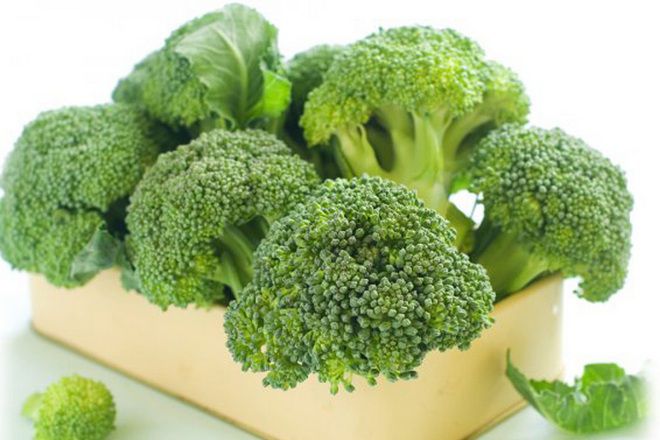

How to grow broccoli in your garden?
Although broccoli is known to be cold hardy, growing cabbage in open ground is not suitable for all regions. The timing of sowing seeds in the garden is the end of May. The earth should already be warmed up to + 20 ° С. The following fertilizers should be applied to the ground in advance:
- organic;
- wood ash;
- urea;
- superphosphate.
Seeds must be properly prepared before sowing. This is done according to the following algorithm:
- We place the seeds in warm water (+ 50 ° C) for 15 minutes.
- We immerse them in cold water for a minute.
- We treat overnight (12 hours) with a solution of trace elements.
- We wash the seeds thoroughly.
- We put it in the refrigerator for a day.
- We dry it.
In addition to directly sowing seeds on the garden bed, pre-growing seedlings in boxes is practiced. In this case, seed preparation is identical to that described above. They are sown in boxes with prepared soil (turf soil, peat and sand), disinfected with dissolved potassium permanganate. Already on the 3-4th day, the first seedlings appear, and after 40 days they can be planted in a permanent place, observing the planting scheme 20x50 cm.
The best varieties for outdoors:
- "Vyarus";
- Green Favorite;
- "Emperor";
- "Corvette";
- "Comanche";
- "Lucky";
- Marathon.
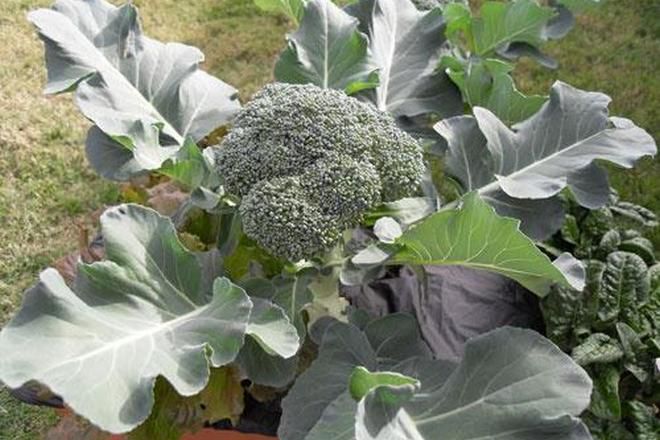

Growing broccoli in a greenhouse
Greenhouse owners are interested in the natural question of how to properly grow broccoli in a greenhouse protected ground. The preparation of seed for planting and the process of growing seedlings are exactly the same as in the case of planting in an open bed. When planning to grow broccoli in a greenhouse using a seedling method, the seeds are sown 1-1.5 months before planting in a permanent place of growth. The beds in the greenhouse are filled with organic matter and mineral fertilizers since autumn.The soil should be neutral or slightly acidic. In early spring, the soil is watered with nitrogen fertilizers.
The best varieties of broccoli to grow in a greenhouse:
- "Tone";
- "Lazarus";
- "Vitamin";
- Continental;
- "Caesar";
- "F1 - Broccoli".


Benefit and harm
Generally:
- Broccoli contains many vitamins - C, B1, B2, B5, B6, E, K, PP, folic acid, provitamin A, beta-carotene, as well as important trace elements: potassium, calcium, phosphorus, manganese, iron, zinc, sulfur, selenium.
- It contains the amino acids methionine and choline, which resist the accumulation of cholesterol in the body. In addition, broccoli contains sulforaphane, a substance that has anti-cancer and anti-bacterial properties.
- There is more protein in broccoli than in other types of cabbage - about the same as in chicken eggs or beef.
- The use of broccoli optimizes human metabolism - the musculoskeletal system is strengthened, free radicals are neutralized, the work of the endocrine system improves, and atherosclerosis recedes.
We suggest watching a video about the benefits and dangers of broccoli cabbage:
For men
Important!
Accurate research has proven that eating broccoli is an excellent prevention of prostate cancer. Broccoli contains indole-3-carbinol, which is a precursor to diindolylmethane (DIM), a powerful anti-cancer agent.
This effect is explained by the fact that DIM has an antiandrogenic effect and prevents the growth of cancer cells in the prostate gland. This finding is extremely important, since prostate cancer is the second most common after lung cancer.
Eating broccoli has a beneficial effect on the state of the cardiovascular system.... This reduces the risk of heart attacks and strokes, the risk of which for men is much higher than for the female half of humanity.
We suggest watching a video about the health benefits of broccoli for men:
For women


Indole-3-carbinol and diindolylmethane are effective in the treatment of breast and endometrial tumors, and are also a good prophylactic agent. Studies conducted in 2010-2013 in the Russian Federation have shown that drugs prepared on this basis are useful for benign breast dysplasia (fibrocystic breast disease).
The B vitamins contained in broccoli normalize ovarian function and the production of sex hormones. Vitamin B9 facilitates pregnancy, has a beneficial effect on the development of the fetus and is the prevention of intrauterine malformations.
B vitamins regulate fat metabolism in the body, and this is important for women who are fighting cellulite.
For kids
Broccoli is a hypoallergenic product. The composition of broccoli, balanced in vitamins and microelements, stimulates the development of the baby's immune system. It contains a lot of iron - this is a good help in the prevention of anemia in children. Calcium and potassium, which are present in broccoli, help the normal functioning of the nervous system, increase the resistance of the child's body to stress.
Broccoli promotes good, cheerful well-being of the child, but also relieves excessive excitability closer to going to bed.
Advice
Broccoli is high in fiber. Dishes made from it are satisfying, but at the same time low in calories. They are given to stout children who need a special diet.
The soil
How to plant broccoli outdoors? Much will depend on the soil here. Neutral or slightly alkaline soil is considered optimal. The pH should be between 6.5 and 7.5. Preparing soil for planting seedlings should be done in the fall. You can also do this in the spring, at least a week before the pick. For this, the earth is dug up on a full bayonet and all weeds are removed. It is also necessary to add compost or rotted manure to the soil. If the area is soil with high acidity, lime must be added. You need 200 grams of substance per square meter.
The best time to transplant seedlings into open ground is morning. It is preferable to carry out this procedure in cloudy weather. The optimal pattern is 35 by 50–55 cm. Planting should be carried out in the holes. They are dug out in a few days, and immediately before the procedure, 0.5 liters of water are poured. You can also add 6-7 grams of nitroammophoska. Fertilizer must be mixed with moistened soil. After that, the seedlings are placed in the prepared well. If you used peat-distilled cups, then you can transplant directly into them. After transplanting, the plant is sprinkled with soil, compacted and watered again. It is important to monitor the weather conditions. If frosts are expected, then the seedlings must be covered using plastic or glass jars and bottles. Seedlings can die even with a slight frost.
Secrets of seasoned summer residents
Every gardener and gardener has their own secrets. It's great when professionals don't hide them with them.
Video: Svetlana Samoilova shares her experience in growing broccoli
A couple of years ago, they decided to plant broccoli at the dacha ... The early one grew very quickly - they were even surprised, it turned out very tasty, they ate it fresh in salads. The late one had to wait until September, they fiddled with leaving. But the result is pleasing - late broccoli is even tastier than early one, besides, it can be stored for a long time. I recommend everyone to grow broccoli: there is nothing to be afraid of, cabbage grows normally, and care is no more difficult than for white cabbage.
Michael. Saratov
Broccoli is easier to grow than cauliflower. So why aren't store shelves and market stalls bursting with this vegetable?
Stage three. Dive
Diving, as well as transplanting, the described culture does not tolerate well. Nevertheless, many gardeners still recommend diving broccoli and, if possible, planting it in the soil along with a clod of earth. In the greenhouse, diving can be carried out 14 days after seedling formation. But due to the fact that after picking the growth of crops slows down, the procedure can be performed immediately before transplanting.


Dive broccoli seedlings
You need to dive broccoli in two cases:
- if the seedlings are too thick;
- if the seedlings can already be transplanted, but the air temperature is less than 15 degrees (arrows may form with prolonged cooling).
When diving, the stems descend along the cotyledonous leaves. After 30-40 days, the seedlings can be planted.
Picking
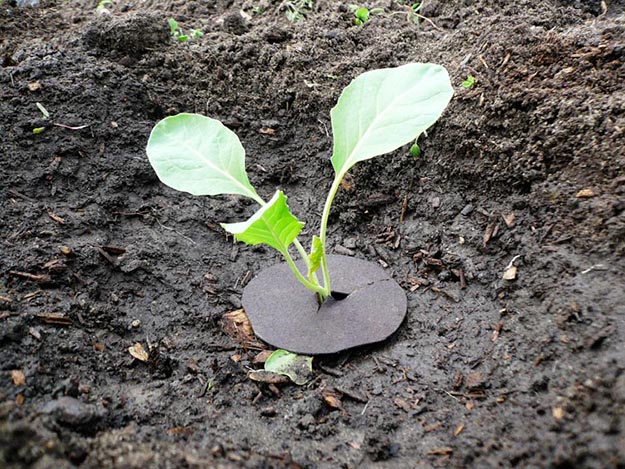

What is this process and what is its peculiarity? Growing broccoli cabbage in the open field from seedlings is not complete without such an important stage as picking. This procedure is usually carried out when the seedlings are already about 2 weeks old. It is convenient to use peat pots as a picking container. No further transplant is required for them. They dissolve well in the soil and at the initial stage will be an excellent additional feeding. The pick is carried out very carefully so as not to damage the roots. It is recommended to fill the cups with soil prepared for sowing. The soil should be additionally moistened with a spray bottle and small depressions should be made in it. After that, with a small stick, you need to select the seedlings from the box and place them in the prepared cups. The soil is compacted and again watered with a spray bottle.
When the seedlings are strong, they should be protected from direct sunlight. If necessary, it can be additionally shaded. At the same time, the air temperature in the room should be increased to 20-22 degrees. After two days, the seedlings should be fed. At this stage, it is best to use a nitroammophoska solution. A tablespoon of complex fertilizer is dissolved in a bucket of water. Each sprout should be watered with 50 grams of this solution. After feeding, the temperature should be lowered again. During the day it is enough to maintain it at 16-18 degrees, and at night 8-10.
It is believed that planting broccoli outdoors will only be successful if the crop is hardened. About two weeks before disembarkation, you should begin to take out the seedlings to the loggia or balcony for 2-3 hours, gradually increasing the time. A few days before planting, the plant should be left in the cold overnight.
How to Harvest Broccoli?
We have already slightly touched on harvesting: you need to know that broccoli cabbage should be harvested before its flowers open. This moment is easy to miss, so you need to keep an eye on the cabbage. There are a number of signs that indicate that the cabbage is ready to be harvested, such as head size: ready for harvesting, they have a diameter of about 12-14 cm. Further - coloration: Broccoli head, ready to pick, is usually dark green in color with the buds closed. At the beginning of the yellowing of the buds, the collection must be carried out immediately, otherwise it will be late, and the entire crop will simply be lost, that is, it will not be tasty and with a reduced nutritional value.
Harvesting broccoli cabbage must be done in the morning when it is in turmoil. In this case, it is advisable not to cut off the heads, namely to cut them off, using the sharpest and cleanest knife for this.
Most often, 60-65 days pass from the moment the shoots emerge on the soil surface until the first harvest, usually broccoli collection continues until mid-September. The entire crop must be harvested before frost.
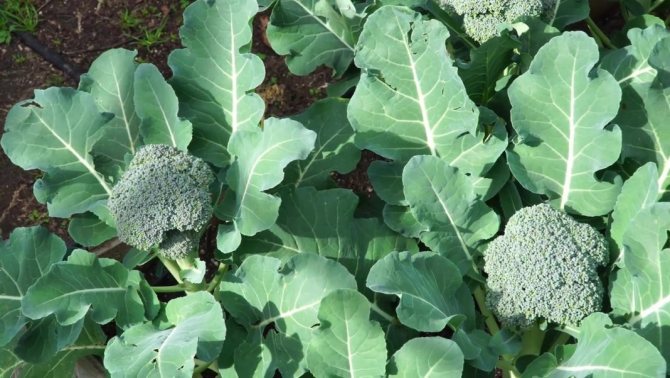

Broccoli, or Asparagus.
Planting care
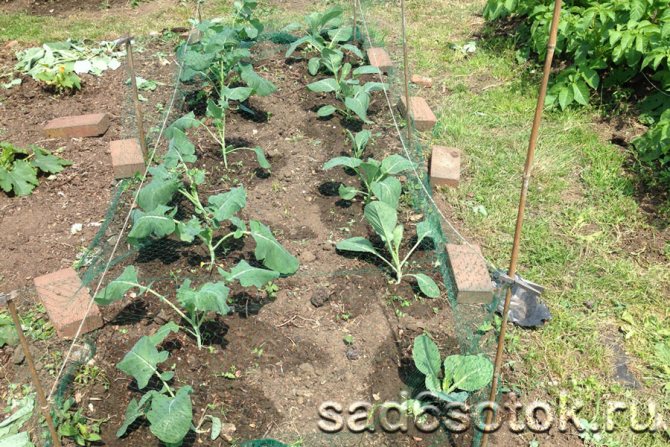

Broccoli planting care
In general, the broccoli culture is quite unpretentious, does not require many laborious techniques that are required for other vegetables - pinching, garters or numerous dressings. The main planting care is weeding, watering, double fertilization and pest and disease control.
With the emergence of seedlings or immediately after rooting of seedlings, weeds are regularly removed, which is especially important until the leaves close in a row, after which powerful cabbage rosettes will drown out most weeds.
The main thing in obtaining strong juicy heads with delicate inflorescences is the development of a strong leaf rosette, the condition for which is sufficient watering and feeding.
Watering
Plants are watered abundantly, at least once or twice a week, depending on weather conditions and the phase of broccoli development. At first, 2-3 liters of water are poured under each root, at the beginning of tying the heads, the watering rate is increased to 4 liters.
With automatic irrigation, they try to direct weak streams of water into frequent furrows for a fairly long period of time - up to 6 hours, achieving gradual and high-quality soil moistening and closing the borders of irrigation furrows. The ideal irrigation method for growing moisture-loving broccoli is with drip irrigation.
Immediately after watering, mulching is carried out with available materials - humus, compost, sawdust. If mulch is not used, loosening is carried out the next day, breaking the crust. For growing vegetables, it is convenient to use black film or agrofibre with slots in which seedlings are planted, which allows you to create an optimal microclimate at the roots, avoid injury to them and restrain the growth of weeds.
Top dressing
If fertilizers were applied in full during the preparation of the site and nutrient pots were used for growing seedlings, the first feeding can be skipped and limited to the second feeding.
First time broccoli is fertilized 14 days after planting or the emergence of full shoots with complex fertilization with a predominance of the nitrogen component or nitrogen fertilizer at the rate of 20 g of ammonium nitrate per 10 liters of water, which should be enough for watering 1–1.5 sq. m. You can use urea at the rate of 30 g per 10 liters of water.
Second feeding is carried out before the formation of heads with complex mineral fertilizer, for which they successfully use Kristalon universal at the rate of 10 g per 10 l of water or independently prepare a mixture of 20 g of ammonium nitrate, 40 g of superphosphate and 10 g of potassium salt per 10 l of water.
Broccoli is not as demanding on the nutritional value of the soil as cauliflower, and to get the main crop it is quite possible to limit yourself to two dressings. But to accelerate the formation of heads, 5-7 days after the second feeding, it is advisable to fertilize the plants with a complex of trace elements containing boron, or use a solution of boric acid at the rate of 1 teaspoon per 30 liters of water.
Pest control
As a cabbage crop, broccoli is susceptible to attacks by a variety of cruciferous pests. Young plantings and seedlings are especially annoyed by fleas that appear in early spring.
To combat the scourge, pollination with wood ash or pyrethrum powder is used. The holes near the plants are sprinkled with a mixture of ash and lime-fluff, which at the same time will scare off the flea, serve as fertilizer and lower the acidity of the soil. If the weather is hot and the flea causes great damage, spraying with insecticides is used, for example, chlorophos solution in a proportion of 1 g per 1 liter of water.
All kinds of caterpillars - scoops, moths, whites - are capable of eating leaves, weakening plants and leading to loss of yield. A laborious but environmentally friendly way of fighting is to inspect the lower part of the leaf and destroy the egg clutches, as well as collect the caterpillars. Pests do not like the taste of wormwood and the smell of tomato tops, so the beds can be sprayed with infusions of these plants.
To prepare an effective infusion, 4 kg of green mass of tomatoes or wormwood are cut, 10 liters of boiling water are poured in and insisted for two days. When spraying, take 2 liters of solution per 10 liters of water, add a little washing powder or laundry soap for stickiness and carry out the treatment.
What varieties are there, how to choose for growing?
The choice of broccoli variety most of all depends on the climatic conditions of the region in which it is supposed to be grown.
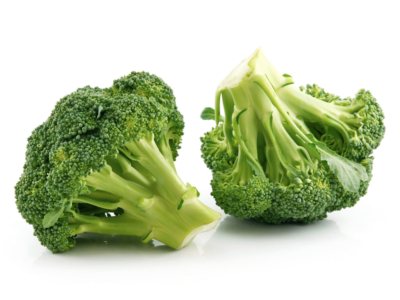

Early ripe:
- Batavia F1.
- Vitamin.
- Vyarus.
- Emperor F1.
- Corvent F1.
- Laser F1.
- Monaco F1.
- Tone.
Mid-season:
- Ironman F1.
- Atlantic.
- Arcadia F1.
- Balboa F1.
- Genoa.
- Dwarf.
- Greenbelt.
- Green.
- Favorite F1.
- Monton F1.
- Fortune.
- Caesar.
Late:
- Agassi F1.
- Lucky F1.
- Marathon F1.
- Parthenon F1.
How is it used?
In folk medicine
Fresh broccoli juice is used for insomnia and liver diseases, as well as for sunburn. Tincture of seeds is used for helminthiasis.
In cooking
Broccoli can be:
- cook;
- extinguish;
- fry;
- bake;
- steam or microwave.
It can be used as an independent dish or as a side dish. Broccoli is used to prepare delicious soups, mashed soups, and main courses. You can use broccoli as an original pie filling.
In all culinary recipes, broccoli can successfully replace cauliflower.


